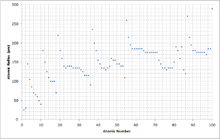


The atomic radius of a chemical element is a measure of the size of its atom, usually the mean or typical distance from the center of the nucleus to the outermost isolated electron. Since the boundary is not a well-defined physical entity, there are various non-equivalent definitions of atomic radius. Four widely used definitions of atomic radius are: Van der Waals radius, ionic radius, metallic radius and covalent radius. Typically, because of the difficulty to isolate atoms in order to measure their radii separately, atomic radius is measured in a chemically bonded state; however theoretical calculations are simpler when considering atoms in isolation. The dependencies on environment, probe, and state lead to a multiplicity of definitions.
Depending on the definition, the term may apply to atoms in condensed matter, covalently bondinginmolecules, or in ionized and excited states; and its value may be obtained through experimental measurements, or computed from theoretical models. The value of the radius may depend on the atom's state and context.[1]
Electrons do not have definite orbits nor sharply defined ranges. Rather, their positions must be described as probability distributions that taper off gradually as one moves away from the nucleus, without a sharp cutoff; these are referred to as atomic orbitals or electron clouds. Moreover, in condensed matter and molecules, the electron clouds of the atoms usually overlap to some extent, and some of the electrons may roam over a large region encompassing two or more atoms.
Under most definitions the radii of isolated neutral atoms range between 30 and 300 pm (trillionths of a meter), or between 0.3 and 3 ångströms. Therefore, the radius of an atom is more than 10,000 times the radius of its nucleus (1–10 fm),[2] and less than 1/1000 of the wavelength of visible light (400–700 nm).

For many purposes, atoms can be modeled as spheres. This is only a crude approximation, but it can provide quantitative explanations and predictions for many phenomena, such as the density of liquids and solids, the diffusion of fluids through molecular sieves, the arrangement of atoms and ions in crystals, and the size and shape of molecules.[citation needed]
In 1920, shortly after it had become possible to determine the sizes of atoms using X-ray crystallography, it was suggested that all atoms of the same element have the same radii.[3] However, in 1923, when more crystal data had become available, it was found that the approximation of an atom as a sphere does not necessarily hold when comparing the same atom in different crystal structures.[4]
Widely used definitions of atomic radius include:
The following table shows empirically measured covalent radii for the elements, as published by J. C. Slater in 1964.[9] The values are in picometers (pm or 1×10−12 m), with an accuracy of about 5 pm. The shade of the box ranges from red to yellow as the radius increases; gray indicates lack of data.
Period
(row)
H
25
Li
145
Be
105
B
85
C
70
N
65
O
60
F
50
Na
180
Mg
150
Al
125
Si
110
P
100
S
100
Cl
100
K
220
Ca
180
Sc
160
Ti
140
V
135
Cr
140
Mn
140
Fe
140
Co
135
Ni
135
Cu
135
Zn
135
Ga
130
Ge
125
As
115
Se
115
Br
115
Rb
235
Sr
200
Y
180
Zr
155
Nb
145
Mo
145
Tc
135
Ru
130
Rh
135
Pd
140
Ag
160
Cd
155
In
155
Sn
145
Sb
145
Te
140
I
140
Cs
260
Ba
215
*
Lu
175
Hf
155
Ta
145
W
135
Re
135
Os
130
Ir
135
Pt
135
Au
135
Hg
150
Tl
190
Pb
180
Bi
160
Po
190
Ra
215
**
*
La
195
Ce
185
Pr
185
Nd
185
Pm
185
Sm
185
Eu
185
Gd
180
Tb
175
Dy
175
Ho
175
Er
175
Tm
175
Yb
175
**
Ac
195
Th
180
Pa
180
U
175
Np
175
Pu
175
Am
175

The way the atomic radius varies with increasing atomic number can be explained by the arrangement of electrons in shells of fixed capacity. The shells are generally filled in order of increasing radius, since the negatively charged electrons are attracted by the positively charged protons in the nucleus. As the atomic number increases along each row of the periodic table, the additional electrons go into the same outermost shell; whose radius gradually contracts, due to the increasing nuclear charge. In a noble gas, the outermost shell is completely filled; therefore, the additional electron of next alkali metal will go into the next outer shell, accounting for the sudden increase in the atomic radius.
The increasing nuclear charge is partly counterbalanced by the increasing number of electrons, a phenomenon that is known as shielding; which explains why the size of atoms usually increases down each column. However, there is one notable exception, known as the lanthanide contraction: the 5d block of elements are much smaller than one would expect, due to the weak shielding of the 4f electrons.
Essentially, the atomic radius decreases across the periods due to an increasing number of protons. Therefore, there is a greater attraction between the protons and electrons because opposite charges attract, and more protons create a stronger charge. The greater attraction draws the electrons closer to the protons, decreasing the size of the particle. Therefore, the atomic radius decreases. Down the groups, atomic radius increases. This is because there are more energy levels and therefore a greater distance between protons and electrons. In addition, electron shielding causes attraction to decrease, so remaining electrons can go farther away from the positively charged nucleus. Therefore, the size, or atomic radius, increases.
The following table summarizes the main phenomena that influence the atomic radius of an element:
factor
principle
increase with...
tend to
effect on radius
electron shells
quantum mechanics
principal and azimuthal quantum numbers
increase down each column
increases the atomic radius
nuclear charge
attractive force acting on electrons by protons in nucleus
atomic number
increase along each period (left to right)
decreases the atomic radius
shielding
repulsive force acting on outermost shell electrons by inner electrons
number of electrons in inner shells
reduce the effect of nuclear charge
increases the atomic radius
The electrons in the 4f-subshell, which is progressively filled from lanthanum (Z = 57) to ytterbium (Z = 70), are not particularly effective at shielding the increasing nuclear charge from the sub-shells further out. The elements immediately following the lanthanides have atomic radii which are smaller than would be expected and which are almost identical to the atomic radii of the elements immediately above them.[10] Hence lutetium is in fact slightly smaller than yttrium, hafnium has virtually the same atomic radius (and chemistry) as zirconium, and tantalum has an atomic radius similar to niobium, and so forth. The effect of the lanthanide contraction is noticeable up to platinum (Z = 78), after which it is masked by a relativistic effect known as the inert-pair effect.[citation needed]
Due to lanthanide contraction, the 5 following observations can be drawn:
The d-block contraction is less pronounced than the lanthanide contraction but arises from a similar cause. In this case, it is the poor shielding capacity of the 3d-electrons which affects the atomic radii and chemistries of the elements immediately following the first row of the transition metals, from gallium (Z = 31) to bromine (Z = 35).[10]
The following table shows atomic radii computed from theoretical models, as published by Enrico Clementi and others in 1967.[11] The values are in picometres (pm).
Period
(row)
H
53
He
31
Li
167
Be
112
B
87
C
67
N
56
O
48
F
42
Ne
38
Na
190
Mg
145
Al
118
Si
111
P
98
S
88
Cl
79
Ar
71
K
243
Ca
194
Sc
184
Ti
176
V
171
Cr
166
Mn
161
Fe
156
Co
152
Ni
149
Cu
145
Zn
142
Ga
136
Ge
125
As
114
Se
103
Br
94
Kr
88
Rb
265
Sr
219
Y
212
Zr
206
Nb
198
Mo
190
Tc
183
Ru
178
Rh
173
Pd
169
Ag
165
Cd
161
In
156
Sn
145
Sb
133
Te
123
I
115
Xe
108
Cs
298
Ba
253
*
Lu
217
Hf
208
Ta
200
W
193
Re
188
Os
185
Ir
180
Pt
177
Au
174
Hg
171
Tl
156
Pb
154
Bi
143
Po
135
At
127
Rn
120
**
*
La
226
Ce
210
Pr
247
Nd
206
Pm
205
Sm
238
Eu
231
Gd
233
Tb
225
Dy
228
Ho
226
Er
226
Tm
222
Yb
222
**